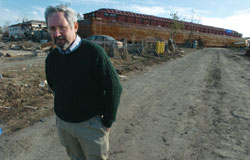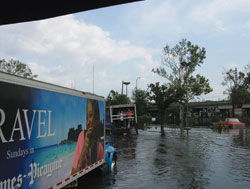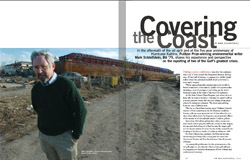Covering the Coast
In the aftermath of the oil spill and at the five-year anniversary of Hurricane Katrina, Pulitzer Prize-winning environmental writer Mark Schleifstein, BA '75, shares his experience and perspective on the reporting of two of the Gulf's greatest crises.
During a press conference days after the explosion that took 11 lives aboard the Deepwater Horizon drilling ship off the Gulf of Mexico, Louisiana Gov. Bobby Jindal talked about the potential landfall of oil as if it were a man-made tempest.
"We're approaching this situation just as we would do before a hurricane comes ashore," Jindal told reporters after declaring a state of emergency and calling up the state's National Guard in the wake of the April 20 explosion.
At the New Orleans Times-Picayune, part of my job is to keep tabs on tropical weather—advising the paper's staff on a storm's progress toward the city and writing about preparations by emergency planners. The storm approaching, however, was a different story.
"We are in a breathless waiting game," Melanie Driscoll, director of bird conservation for the National Audubon Society, told me in an interview just 10 days after the accident when asked about the long-term environmental effects of the release of oil that already totaled 2 million gallons.
More than 200 million gallons later, when contractors were finally able to plug the well with cement in late August, the uncontrolled release of oil had become the largest spill in U.S. history, almost 20 times the size of that caused by the shoaling of the Exxon Valdez oil tanker in Alaska in 1989.
For New Orleans area residents, the blowout was also devastating psychologically; coming just five years after Hurricanes Katrina and Rita flooded more than 80 percent of homes.
As potentially problematic for the environment as the oil spill might be, it's clear the effects of the spill still pale in comparison to Katrina's devastation of New Orleans and southeastern Louisiana.
My Katrina coverage began long before the actual storm in 2005. A five-day series in 2002, "Washing Away," essentially explained what would happen to the city if a storm of Katrina's magnitude were to hit. The series described that the risk of flooding had been growing for years due to the combined effects of coastal erosion that was destroying the wetlands that provided protection from hurricane storm surges, and an outdated levee system that was sinking under its own weight and was known to be two feet lower in many locations than the Army Corps of Engineers had believed it needed to be.
On the Saturday before Katrina hit, my wife and I began preparations for our evacuation—we would be using The Times-Picayune's building in central New Orleans as our shelter. By 3 p.m., I was back at the paper, at work on the story that would lead Sunday's edition, providing a final warning that leaving the city would be best for all its residents.
That conclusion became clear within minutes of my arrival at the paper, when I was sent the results of a computer model run by researchers at Louisiana State University based on an early morning predicted path provided to them by the National Hurricane Center. The model was based on the center's prediction that Katrina would be a Category 4 hurricane as it brushed along New Orleans' eastern side. It showed the hurricane's storm surge overtopping the easternmost part of the levee system, just as we had predicted in the 2002 series, flooding much of the city's eastern half.
At 4 p.m., the paper's senior editors and publisher were clustered behind my desk, looking at the model on my computer screen. My phone rang and it was Max Mayfield, then director of the National Hurricane Center. On Friday I had requested an interview with him for my Sunday story.

Mark Schleifstein, hurricane and environment reporter in New Orleans.
Ellis Lucia/The Times Picayune
Before I could even say hello, Mr. Mayfield asked, "Mark, how high is your building? What kind of winds can it withstand?"
"Why are you asking me that?" I said, and Mr. Mayfield replied, "Because this is the big one we've always feared."
Katrina looked like it would lose little strength before going ashore and could hit the city directly, causing the entire city to flood.
I explained that our employees could retreat to the second and third floors of our building and that there were interior rooms to which we could go if the windows—made of bullet-proof Lexan—blew out.
The editor of the paper, Jim Amoss, later said my face drained of color during the conversation, and any remaining questions about the tenor of our main story warning residents to evacuate were gone.
By Sunday night, the outer bands of the 450-mile-wide storm were upon us, growing in intensity until 4 a.m., when one of the Lexan windows in the publisher's suite blew in.
We worked around the clock for the next two days, filing stories on our website, even after we lost outside electricity and switched to generator power.
That morning, we were reporting online that residents of St. Bernard Parish, just to the city's east, were climbing onto their rooftops to escape floodwaters. Reports of 8 to 12 feet of water in the Lower Ninth Ward, a nearby New Orleans neighborhood, quickly followed.
In the afternoon, I received word that floodwaters also had caused a section of wall on the 17th Street Canal to fail, and the Lakeview neighborhood, where my home was located, was quickly filling with water.
Two staff members decided to check it out, traveling by bicycle to the north of the paper despite winds that were still 50 miles per hour or higher.
It was several hours before they returned with a harrowing tale—and photographs of water that had risen to the eaves of homes and of people who had climbed onto roofs there, as well. One image showed floodwaters five blocks away from my home.
I later learned that our home was inundated by 12 feet of water, or, as my wife explains to new acquaintances, "We had two feet of water…on the second floor."
By early Tuesday morning, the water was nearing four feet deep in the newspaper's parking lot. It had become clear that the staff could not stay in our building. We had more than 250 people—staff and family members—ranging from newborn babies to elderly in wheelchairs. The paper's delivery truck drivers were warning that if the water didn't stop rising, the trucks would be useless.
Staff members and their families loaded into the boxes of delivery trucks—some headed to Baton Rouge or shelters in smaller towns. About a dozen reporters and editors agreed to hop back onto one of the trucks and return to New Orleans, setting up a work space in a reporter's home in the relatively high uptown area along the river.
The rest of us returned to our trucks and headed 65 miles southwest to Houma, La., where the Houma Courier, owned by The New York Times, had agreed to be our host. In the back of the truck, I listened to a series of public officials giving updates on the radio. I wrote a story based on the chatter.
On Wednesday, reporters and most editors in Houma headed for Baton Rouge, 80 miles northwest of New Orleans, where LSU's Manship School of Mass Communications had set aside its student computer laboratory for us as a temporary newsroom.
In the weeks that followed, we scrambled to find out what had gone wrong with the city's levee system while having to find new places to live, buy new clothes, and find family members.
Between Aug. 29 and Feb. 1, I ended up living in nine different places. My wife did not return to New Orleans permanently until Thanksgiving, by which time I had moved from a one-room apartment over a bar in the French Quarter to a two-room apartment behind another reporter's home in Uptown.
Katrina's devastation placed me in an unusual situation as a reporter. Before the storm, if an editor had come to me and said, "Mark, the Army Corps of Engineers is going to make a series of errors that will cause flood walls to fail and flood your home, and we want you to report on it," I would have told him that it would be a conflict of interest.
But in the aftermath of Katrina, those rules—out of necessity—changed. Katrina destroyed or severely damaged the homes of 40 percent of our staff, and the remaining editorial employees were obviously affected by the lengthy evacuation and the storm's other economic and mental health effects. We had no choice but to place personal feelings aside as we reported on the story.
Thanks to crash courses in civil engineering, our reporting was among the first to show that many of the levee and flood wall failures resulted from errors in design or the use of improper construction materials.
As the levee system was repaired, we were able to spot—and stop—a similar use of improper material to build one levee. We reported continuously on concerns about new design and construction techniques, work that continues to this day. The $14.7 billion post-Katrina levee reconstruction program is scheduled to be substantially complete on June 1, 2011.
However, as our reporting has shown, that system will only protect against storm surges caused by a hurricane with a 1 percent chance of occurring in any year, a so-called 100-year storm. Katrina, however, was a 400-year storm, though the effects of the weaker, western side of the hurricane were in the 150-year to 250-year range.
After five years, we're still reporting on Katrina, even as we attempt to unravel the causes of the BP disaster.
For the first three months after the spill, it felt like the days after Katrina, with reporters working 12 to 18 hours a day, including weekends, to keep up with events.
The oil spill shone a spotlight on unprepared traditional media—national and local radio, television, and newspapers—that have so winnowed down their talent pools that the remaining staffers are hard-pressed to even keep up with the fast-moving events of the blowout and its aftermath.
At The Times-Picayune, financial pressures in 2009 resulted in a first-ever buyout of employees, including the reporter who was covering the oil and gas industry as part of her beat.

Newspaper staff members and their familes evacuate The Times-Picayune building using newspaper delivery trucks after Hurricane Katrina.
Mark Schleifstein
Exacerbating our lack of staff were requirements that reporters take two weeks of unpaid furlough during the first half of 2010. My first week happened to occur the week after the Deepwater Horizon explosion. I spent the first four days at home, dividing time between household chores and keeping an eye on what was happening on the Internet, forwarding to reporters at work a variety of e-mails and notes taken from interviews I wasn't supposed to be doing during my time off.
By Friday, however, I'd had enough. I broke furlough and returned to work, as it became clear that there would be no quick shut-off of the oil flowing into the Gulf. By then, our editors had pulled a half-dozen reporters off other beats and assigned them to cover the spill. But that meant equally important issues, such as more than $7 billion in construction projects that were just getting under way to complete the rebuilding of the failed levee system around New Orleans, were not getting due attention.
The Pew Research Center's Project for Excellence in Journalism in late August gave the media a better grade than I would: "In short, a news industry coping with depleted staffing, decreasing revenues and shrinking ambition was tested by the oil spill and seemed to pass," the report concluded, after studying 2,866 stories about the spill produced from the time of the accident until the end of July.
What the report failed to point out, though, was that very few media outlets had written any stories before the spill explaining the potential for a catastrophic accident or the inherent risks involved in drilling wells that begin a mile below the ocean's surface and don't hit oil until another two miles beneath the earth's crust.
Drilling at depths where men can't survive—the work is done on the mile-deep Gulf floor by remotely controlled submersible vehicles—is less than 20 years old and the technology has been speeding to catch up with the huge oil finds.
That the response to this oil disaster—including the failed attempts to stem the flow of oil from the well, the almost laughable tests of vessels like the "A Whale" supertanker to scoop oil from the surface, and the fight over sand berms that curb the spread of oil—was all unplanned in advance points to a key failure by industry, federal, and state officials to adequately deal with the risk of deepwater drilling.
In the days after the spill, federal officials followed a playbook largely dictated to them by Congress, which passed the Oil Spill Act in 1990 in response to the Exxon Valdez incident. That law required the establishment of a unified command headed by a Coast Guard national incident commander, but also including representatives of the "responsible party" of the oil spill, BP.
And as Coast Guard and other federal agency officials quickly pointed out, the expertise in fighting the oil spill was largely in BP's hands: The experts were oil industry contractors.
The science of the spill also seemed an often unclear mess, punctuated by vocal battles between public officials and scientists and even more clear indications that money would be slow in arriving to underwrite the expensive costs of state-of-the-art research necessary to figure out where the oil and dispersant was and what was their fate.
The threats, on the other hand, were immediately clear. The spill occurred in the midst of spawning periods for many sensitive species in the Gulf of Mexico and along its shoreline.
In the weeks that followed the explosion, it became apparent that the initial accident was likely the result of what I'll call a cascading series of wrong decisions. Just as with the failure of levees and floodwalls in the New Orleans area during the storm surges caused by Hurricane Katrina, independent petroleum engineers were pointing to an engineering concept called "residual risk," which refers to the remaining risks or unknown risks after known risks are taken into account in the design of a structure or a process.
BP was not alone in its failure to understand the importance of residual risk.
Louisiana and other coastal states were ill-prepared for a worst-case oil spill that would threaten wide swaths of their shorelines, as is clear from the mad scramble by states to demand thousands of miles of floating boom material to place between their shorelines and the oil.
Louisiana officials were more prescient than others, warning Congress for more than 10 years that the development of offshore oil and gas had a direct effect on the increasing erosion of the state's wetland areas, as the industry built pipelines and navigation channels through wetlands to bring the oil and gas ashore.
Federal officials were even more circumspect. The Minerals Management Service has been replaced by the new Bureau of Ocean Energy Management, Regulation and Enforcement in the aftermath of the BP spill in part because of several earlier investigations that found MMS and industry officials were too close, and that the agency's regulation of offshore drilling—such as during the BP well's development—was inadequate.
My first story on the spill outlined the lack of information about potential long-term impacts of oil if the leak was not plugged quickly, and it certainly won't be the last to cover that theme.
"To me, this spill results from 30 years of an erosive atmosphere to regulation," said Carl Safina, a marine ecologist and president of the Blue Ocean Institute. "Government's job is to protect most people from potential harm caused by a few people. We still understand that the police are there to protect most of us from a few of us, but for corporations, we do not seem to understand that, and we get major catastrophes as a result."
There is still much work to be done. As we continue to report on the failures of many parties to take into account the risks of deepwater drilling, we get a clearer picture of what goes into the making of a man-made tempest.


 Mark Schleifstein, BA '75, is a three-time Pulitzer Prize-winning hurricane and environmental reporter for The Times-Picayune in New Orleans, where he has worked for more than 25 years.
Mark Schleifstein, BA '75, is a three-time Pulitzer Prize-winning hurricane and environmental reporter for The Times-Picayune in New Orleans, where he has worked for more than 25 years.